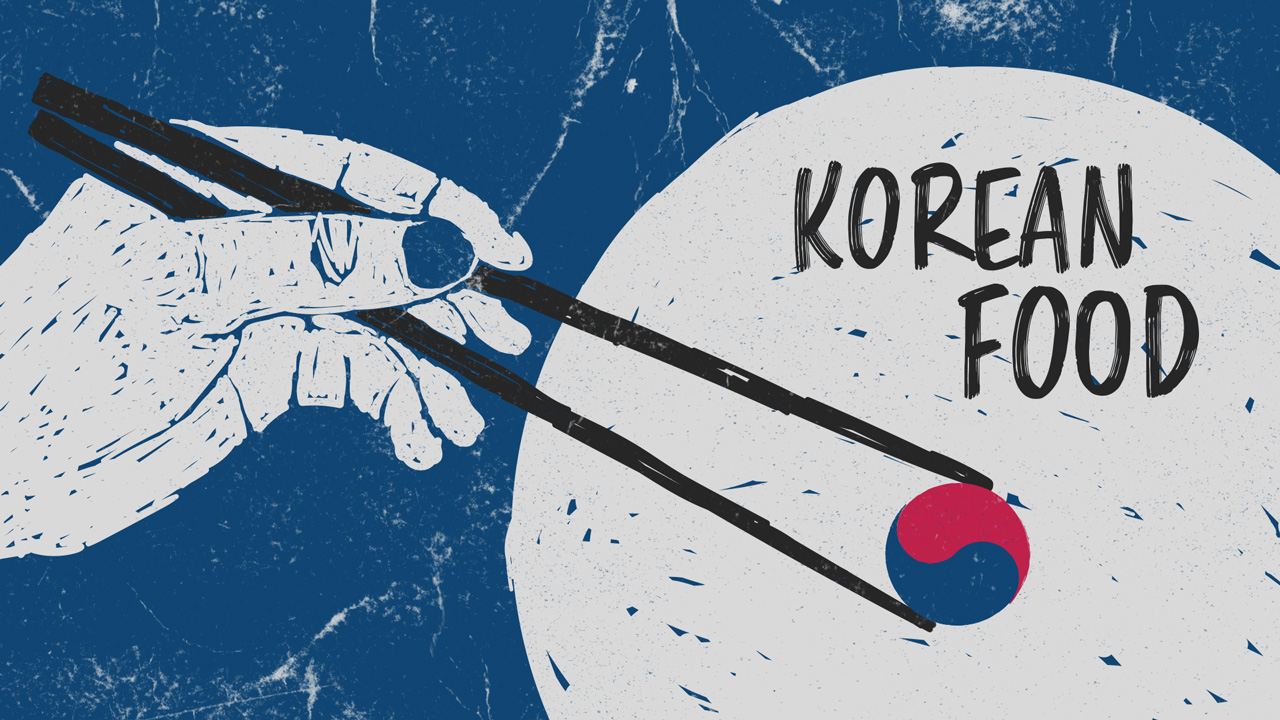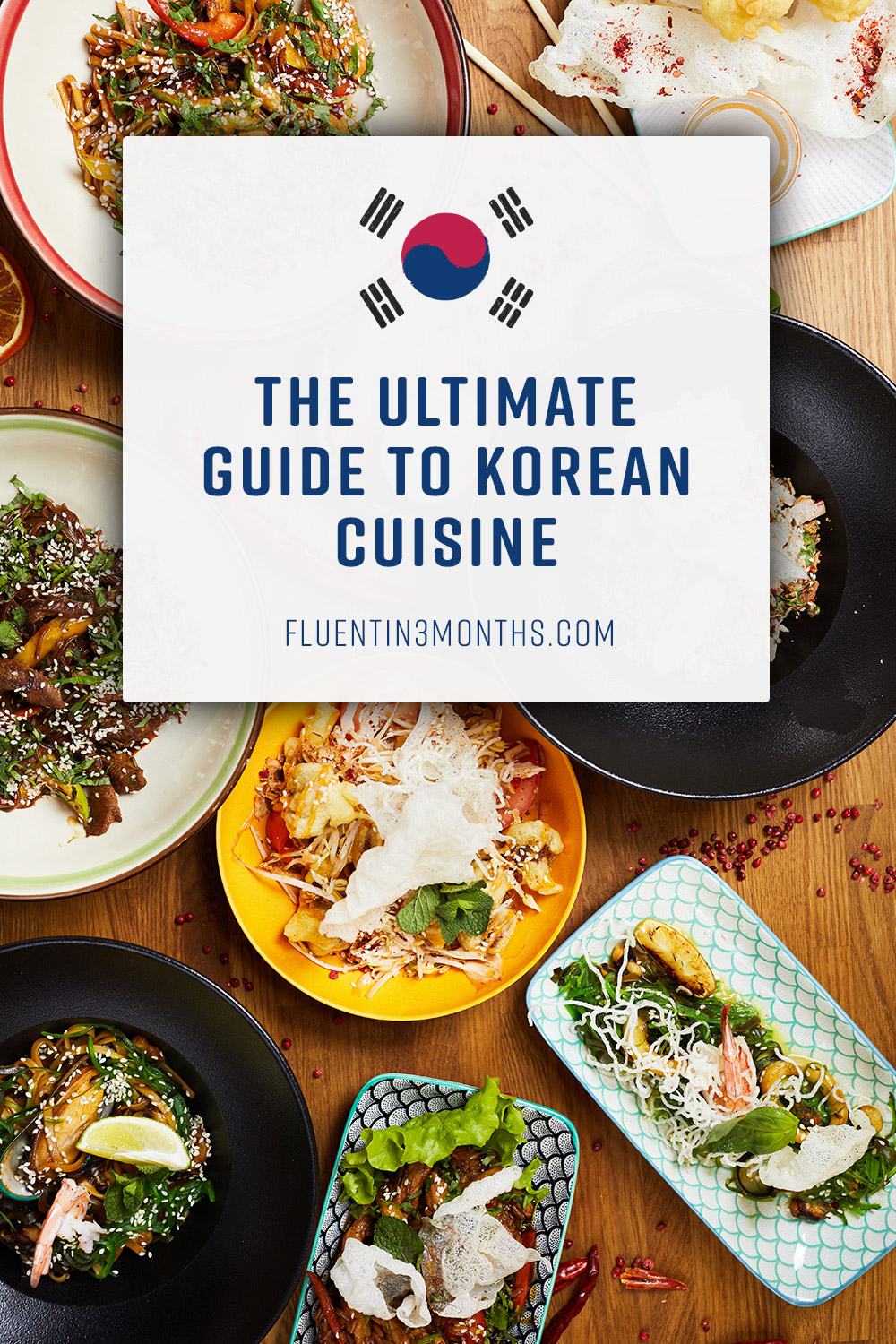“Food” in Korean: The Ultimate Guide to Korean Cuisine
Korean BBQ, street food, and wild dishes… South Korean food has it all! So if you’re a foodie, it’s time to learn all about food in Korean.
When it comes to Korean food, there’s so much to love. But also a lot to learn, and a lot of different tastes to take in!
As with most countries, food plays a big role in Korean relationships, social situations, and culture. So learning to talk about food and the customs around meals is a big step in your Korean language learning journey.
So that’s what we’ll be diving into today. This is your guide to learning all about food in Korean!
Here’s what we’ll be learning:
- Tons of words for food in Korean, as well as for cooking, in the kitchen, and at a restaurant
- Korean cuisine and unique Korean dishes you MUST know about and try (plus a few Korean recipes you can try yourself at home)
- How to order food in Korean
There’s a lot to cover, so let’s jump right in!
Food in Korean: Common Food Words
First, let’s start with how to say “food” in Korean. 음식 (eumsik) means “food”, but sometimes 밥 (bab) is used to say “meal” or “food” even though it means “rice”.
I’m sure you can guess why — almost all Korean dishes include rice! In fact, rice is such a staple that you’ll often be asked this phrase:
밥을 먹었어? bab-il meokeosseo?
It means “Did you eat rice?” but it’s often said as “Did you eat?” Parents will often greet their kids with this phrase in a loving way to show affection, and even friends will say this.
Let’s learn some other food words.
Vegetables in Korean
- Vegetable: 야채 (yachae)
- Onions: 양파 (yangpa)
- Potatoes: 감자 (gamja)
- Sweet potatoes: 고구마 (goguma)
- Avocado: 아보카도 (abokado)
- Pepper: 후추 (huchu)
- Cucumber: 오이 (oi)
- Broccoli: 브로콜리 (beulokolli)
- Cabbage: 양배추 (yangbaechu)
- Carrot: 당근 (dang-geun)
- Eggplant: 가지 (gaji)
- Cauliflower: 콜리플라워 (kollipeullawo)
- Corn: 옥수수 (oksusu)
- Ginger: 생강 (saeng-gang)
- Lettuce: 상추 (sangchu)
- Salad: 샐러드 (saelleodeu)
- Beans: 콩 (kong)
- Garlic: 마늘 (maneul)
Fruit in Korean
- Fruit: 과일 (gwa-il)
- Apple: 사과 (sagwa)
- Pear: 배 (bae)
- Peach: 복숭아 (bogsung-a)
- Raspberry: 산딸기 (santtalgi)
- Strawberry: 딸기 (ttalgi)
- Kiwi: 키위 (kiwi)
- Watermelon: 수박 (subak)
- Blueberry: 블루베리 (beulluberi)
- Banana: 바나나 (banana)
- Grapes: 포도 (podo)
- Pineapple: 파인애플 (painaepeul)
- Cherry: 체리 (cheri)
- Lemon: 레몬 (lemon)
Meat and Fish in Korean
- Meat: 고기 (gogi)
- Fish: 생선 (saengseon)
- Salmon: 연어 (yeon-eo)
- Pork: 돼지 고기 (dwaeji gogi)
- Beef: 소고기 (sogogi)
- Chicken: 닭고기 (dalg-gogi)
- Egg: 계란 (gyeran)
Pantry and Refrigerator Staples in Korean
- Bread: 빵: (ppang)
- Flour: 밀가루 (milgaru)
- Yogurt: 요거트 (yogeoteu)
- Dairy: 유제품 (yujepum)
- Cheese: 치즈 (chijeu)
- Butter: 버터 (beoteo)
- Sugar: 설탕 (seoltang)
- Salt: 소금 (sogeum)
- Chocolate: 초콜릿 (chokollit)
- Cinnamon: 시나몬 (sinamon)
- Honey: 꿀 (kkul)
- Vanilla: 바닐라 (banilla)
- Pizza: 피자 (pija)
- Candy: 캔디 (kaendi)
- Olive oil: 올리브유 (ollibeuyu)
- Vinegar: 식초 (sikcho)
- Soy sauce: 간장 (ganjang)
- Ingredients: 성분 (seongbun)
Drinks in Korean
- Drink/Beverage: 음료 (eumryo)
- Water: 물 (mul)
- Coffee: 커피 (keopi)
- Tea: 차 (cha)
- Milk: 우유 (uyu)
- Juice: 주스 (juseu)
- Wine: 와인 (wain)
- Beer: 맥주 (maekju)
- Soda: 탄산음료 (tansaneumryo)
Korean Cooking and Korean Kitchen Vocab
- Plate/Bowl: 그릇 (geuleut)
- Cup: 컵 (keop)
- Spoon: 숟가락 (sudgarak)
- Fork: 포크 (pokeu)
- Knife: 칼 (kal)
- Pot: 냄비 (naembi)
- Pan: 팬 (paen)
- Cookbook: 요리책 (yorichaek)
- Blender: 블렌더 (beullendeo)
- Microwave: 전자레인지 (jeonja reinji)
- Toaster: 토스터 (toseuteo)
- Spatula: 주걱 (jugeok)
- Cutting board: 도마 (doma)
- Stove: 스토브 (seutobeu)
- Oven: 오븐 (obeun)
- Refrigerator: 냉장고 (naengjanggo)
- Freezer: 냉동고 (naengdonggo)
- Trashcan: 통 (tong)
- Sink: 싱크 (singkeu)
- Kitchen: 부엌 (bueok)
- Coffee pot: 커피 포트 (keopi poteu)
And some verbs:
- To cook: 요리하다 (yorihada)
- To stir: 휘젓다 (hwijeosda)
- To chop: 썰다 (sseolda)
- To mix: 섞다 (seokkda)
- To eat: 먹다 (meokda)
- To drink: 마시다 (masida)
- To make: 만들다 (mandeulda)
- To taste: 맛보다 (masboda)
- To pour: 붓다 (busda)
Don’t worry if your head is spinning with new food vocab. Learn what’s relevant to you and skip the rest!
It’s a good idea to add these to a flashcard app like Anki to help you remember them.
Korean Cuisine: Korean Dishes
Authentic Korean food is some of the best food out there, and it’s actually quite healthy for you too. Most Korean meals are well-balanced with protein, veggies, and rice or noodles.
More often than not, your plate will have at least 2 – 3 different types of veggies in all different colors of the rainbow. Plus, many foods have a lot of spice to them, thanks to chili, ginger, and garlic.
And I’m sure you know the Korean staple, 김치 (kimchi), which is one of the healthiest foods thanks to its probiotic goodness and high amount of vitamins and minerals.
Besides that, Koreans tend to take the approach that food is medicine, so many dishes are made with that approach (and you’ll see one listed below).
So, you can use this as an excuse to be a foodie… for your health. 😉
Here are some must-try Korean dishes.
Bibimbap
Similar to a buddha bowl, 비빔밥 (bibimbap) serves several different kinds of veggies with rice, and meat or a fried egg (or sometimes both).
The nice thing about bibimbap is it’s super customizable. You can adjust the spice level, use leftovers to throw together a quick lunch, and change out the veggies.
Plus, they make beautiful, colorful bowls that are Instagram worthy!
Bulgogi
This is definitely one of the most popular Korean dishes. 불고기 (bulgogi) is thinly sliced meat that you can grill up, usually with a slightly sweet flavor. It’s a simple dish that’s usually wrapped in lettuce and eaten with rice.
Japchae
잡채 (japchae) is a stir-fry sweet potato noodle dish, with veggies in sesame oil. It’s often eaten as a side dish, both hot or cold.
You can try making japchae at home with this Korean recipe from Maangchi.
Mandu
만두 (mandu) are Korean dumplings, stuffed with beef, pork or veggies. If you’ve ever had Japanese gyoza, these are similar!
They’re a traditional food that’s eaten around the Korean Lunar New Year for good luck. They can be steamed or pan-fried. The steamed mandu are called 찐만두 (jjinmandu).
Galbi
갈비 (galbi), which means “rib”, is super popular at Korean BBQ restaurants.
Galbi can be any type of meat (usually pork or beef, though), steeped in a sugary-soy sauce and garlic marinade and then flame-cooked to perfection. It’s so tender and flavorful — just a bit sweet — and oh so good.
Bossam
This is a super simple dish, but quite tasty. 보쌈 (bossam) is bite-sized steamed pork cuts served on a platter with lettuce and dipping sauces.
All you do is snag a piece of meat, wrap the lettuce around it, and dip it in the sauce.
It’s so simple but really yummy!
Haejangguk
Do you remember that music video Psy did with Snoop Dog, Hangover? No? Well, it was one big parody of drinking culture in Korea.
Because drinking in Korea can be intense. So much so, they’ve come up with 해장국 (haejangguk) — “hangover soup”.
But be prepared: one type of haejangguk, called seonjiguk, is made with chunks of congealed ox blood. Another type, sundaeguk, is made with intestines stuffed with pig’s blood.
But standard ol’ haejangguk is normally made with cabbage, beef chuck, veggies, fish sauce, and more. It’s high in sodium, and supposed to help cure a hangover.
Just make sure you ask which kind of haejangguk you’re getting if you want to steer clear of ox blood and pig intestines.
Hotteok
If you’ve got a sweet tooth, you’ll love this one! 호떡 (hotteok) is a fried pancake stuffed with goodness. It’s usually stuffed with things like honey, cinnamon, nuts, or brown sugar syrup.
Hotteok is a popular choice for Korean street food, but you could even make it at home with recipes like this one from My Korean Kitchen.
Gimbap
김밥 (gimbap) is similar to sushi, but it’s normally filled with a variety of things instead of fish. Also, the rice is prepared differently, so gimbap is a bit sweeter.
It’s common to find gimbap filled with ham or beef, such as thin slices of bulgogi.
This is another popular grab-and-go snack and street food.
Budae Jjigae
I can’t talk about Korean cuisine without mentioning 부대찌개 (budae jjigae), “Army Stew”. It was made popular after the Korean War, when Koreans became exposed to American staples like canned beans, Spam, and American cheese.
So they got creative with it and made a stew.
It often has sausage or hot dogs, bacon, spam, kimchi, ramyeon noodles, and more. It’s a spicy, savory dish that sounds a bit strange but it’s a must-try!
Korean Bapsang has an Army Stew recipe you can try cooking up, as well as many more traditional Korean food recipes on her site.
Of course, this is just the tip of the iceberg with Korean food. There are way more varieties, many of which are on the wild, exotic side like dakbal, chicken feet, sannakji, live octopus, or gaebul, raw sea worms.
90 Day Korean has a great article listing even more foods, especially some of these wilder ones.
How to Order Food in Korean
If you’re traveling to South Korea, you absolutely need to know how to order lots of food. So here are some handy phrases to get you started:
- “Hey!” or “Over here!” (To get a waiter’s attention) – 여기요 (yeogiyo)
- “Can I have a menu please?” – 메뉴 좀주세요 (menyu jom juseyo)
- “What do you recommend (on the menu)?” – 추천 메뉴가 무엇인가요? (chucheon menyuga mueosingayo)
- “What is this?” – 이게 뭐예요? (ige mwoyeyo)
- “This, please.” – 이거주세요 (igeo juseyo)
- “I’m allergic to…” – 저(은/는) 알레르기 있어요. (*jeo[eun/neun] __ allereugi isseoyo*)
- “I’m vegetarian.” – 채식주의자에요 (chaesikjuuijaeyo)
- “Can I have __ please?” – ___좀주세요. (__ jom juseyo)
- “More water, please.” – 물 좀 더주세요 (mul jom deojuseyo)
- “Not spicy, please.” – 안 맵게 해주세요 (an maebge haejuseyo)
- “Without __, please.” – ___없이 제발주세요 (__ eobsi jebal juseyo)
- “Please give me more of this.” – 이거 좀 더 주세요 (igeo jom deo juseyo)
- “Can I have the bill, please?” – 계산서 좀 주실 래요? (gyesanseo jom jusillaeyo)
- “Would you like to order?” – 주문하시겠어요? (jumunhasigesseoyo)
Bonafide Korean Foodie!
You’re ready to go explore all the culinary delights of South Korea now! Place your order and eat up.
Next, you can learn even more about Korean culture or learn how to master your manners with please and thank you.




Social